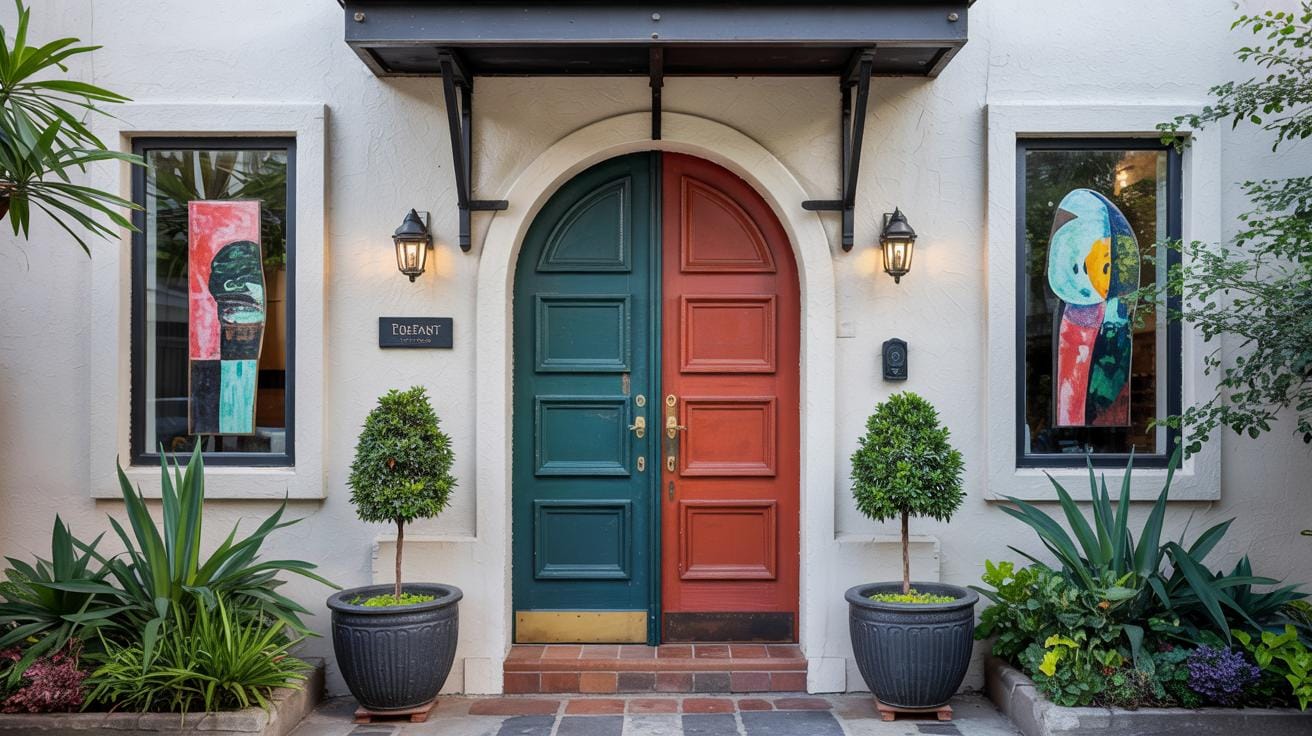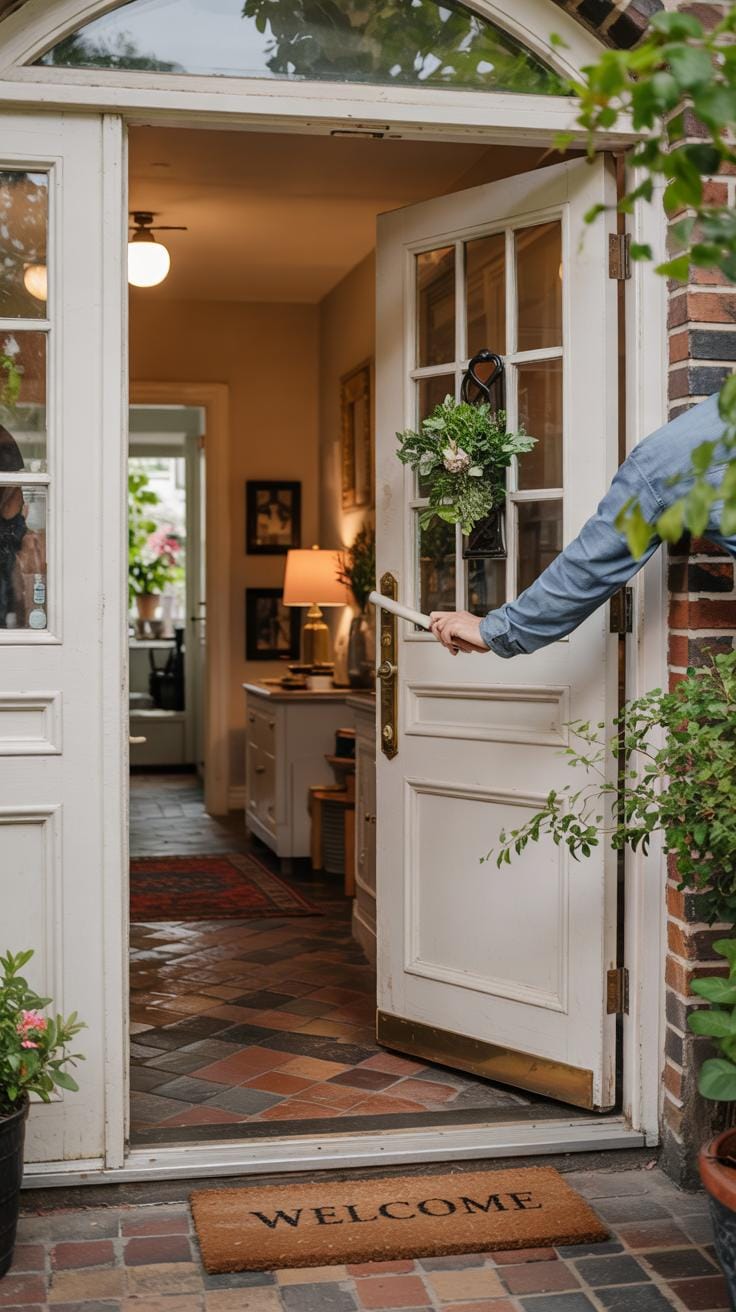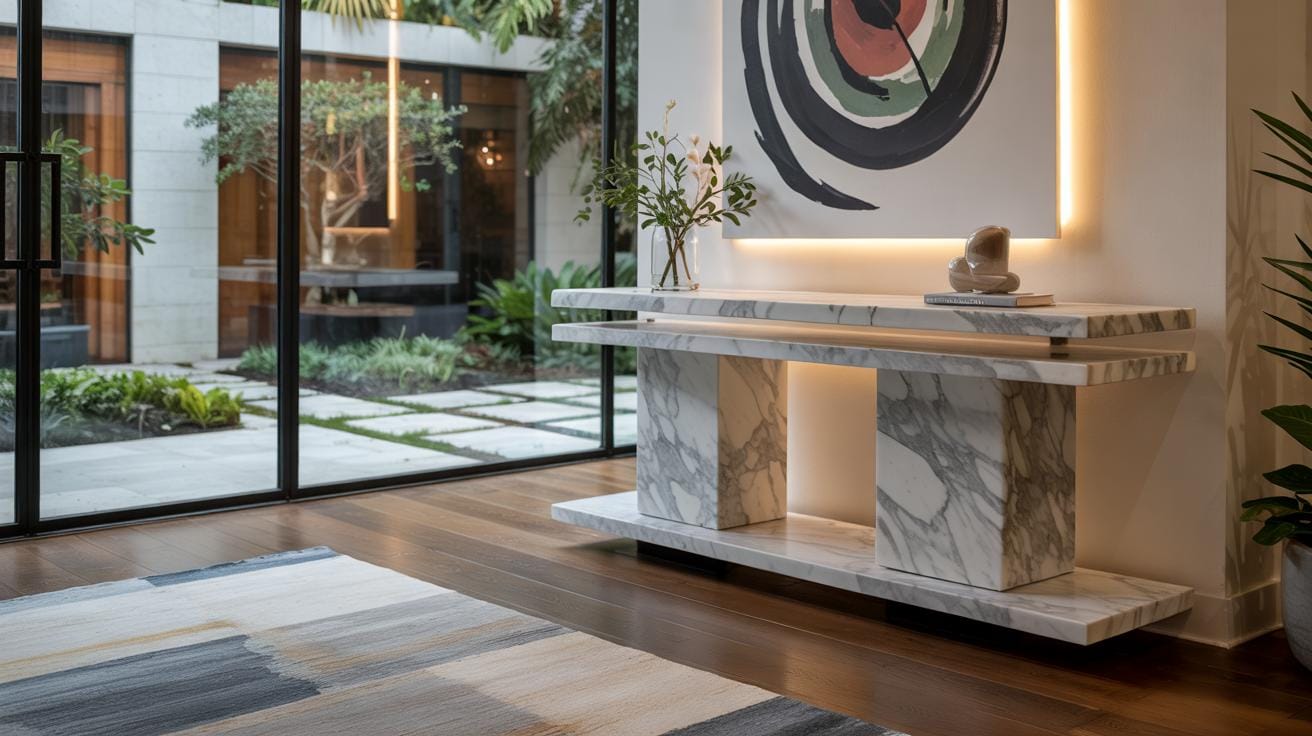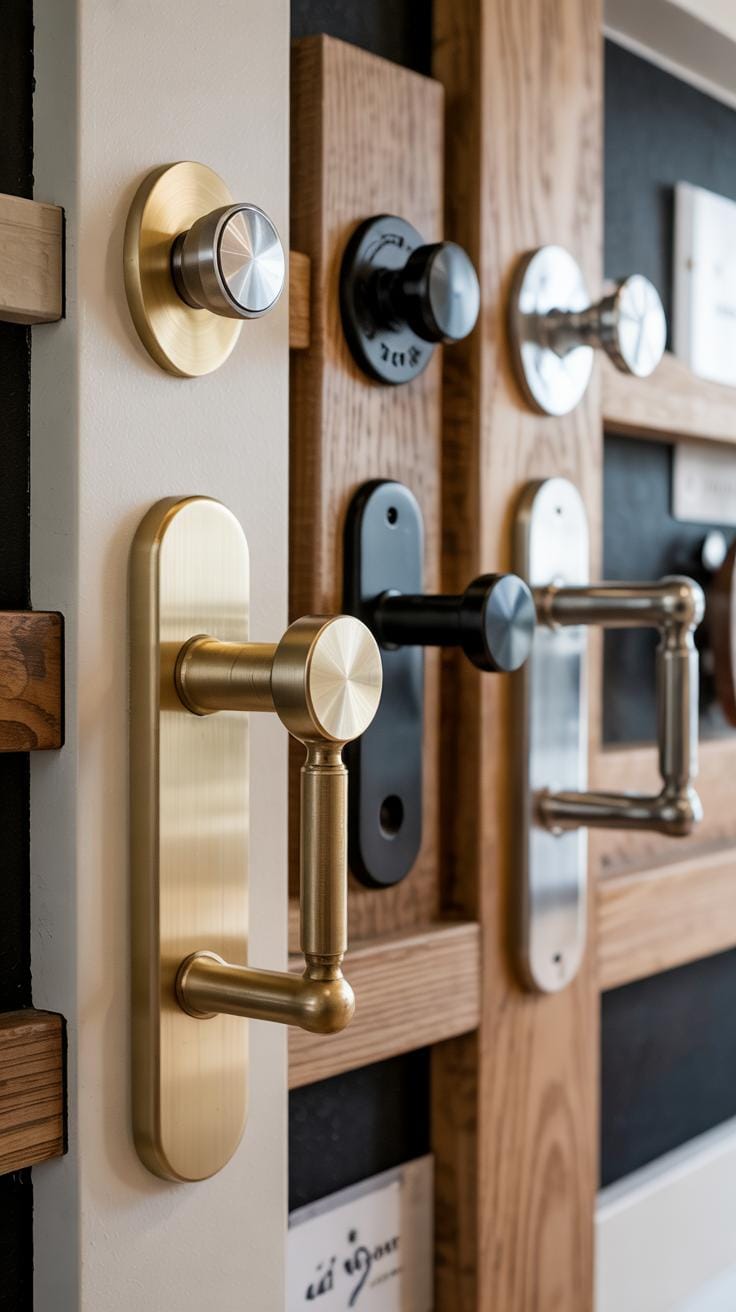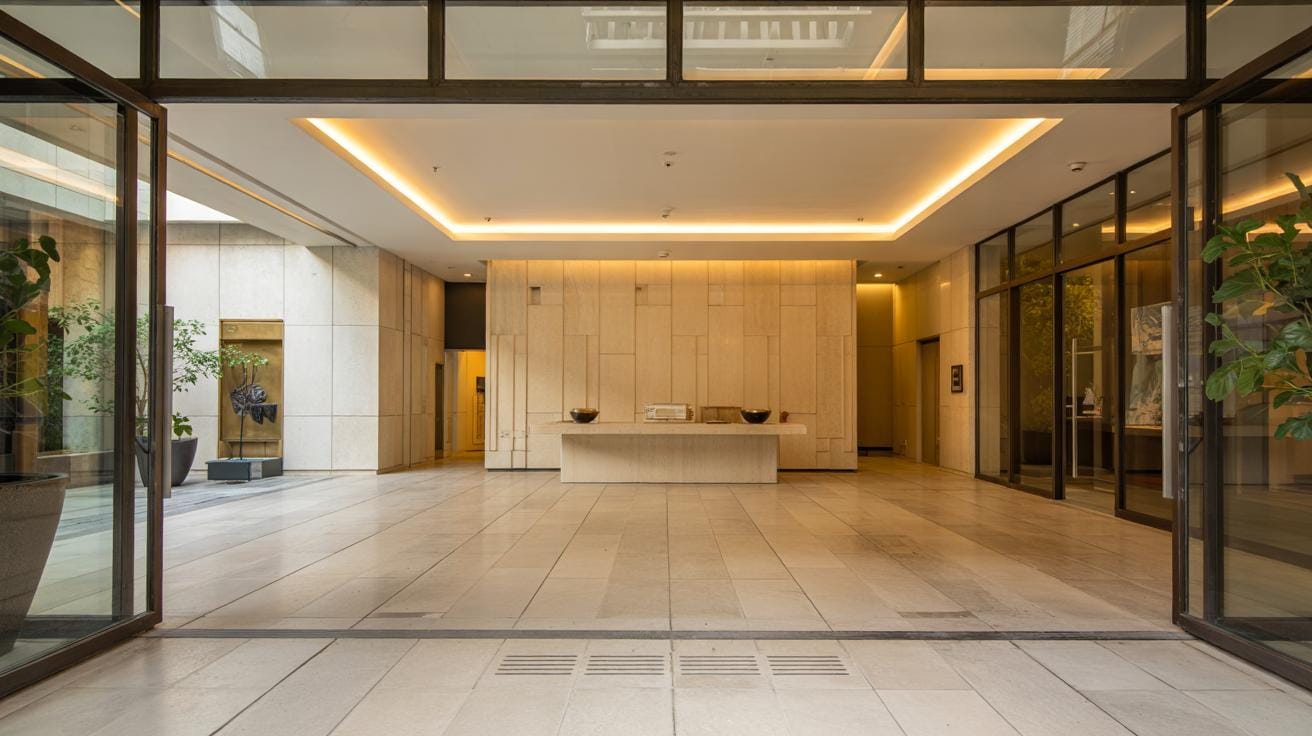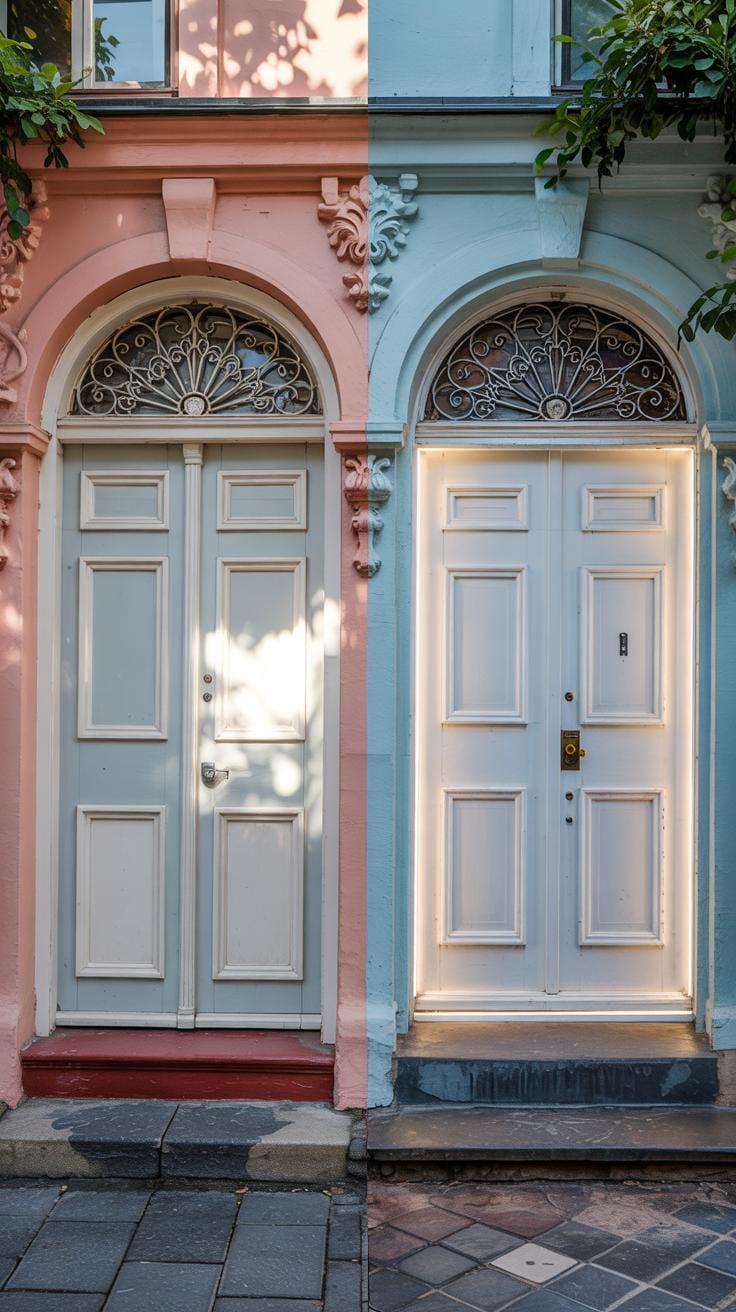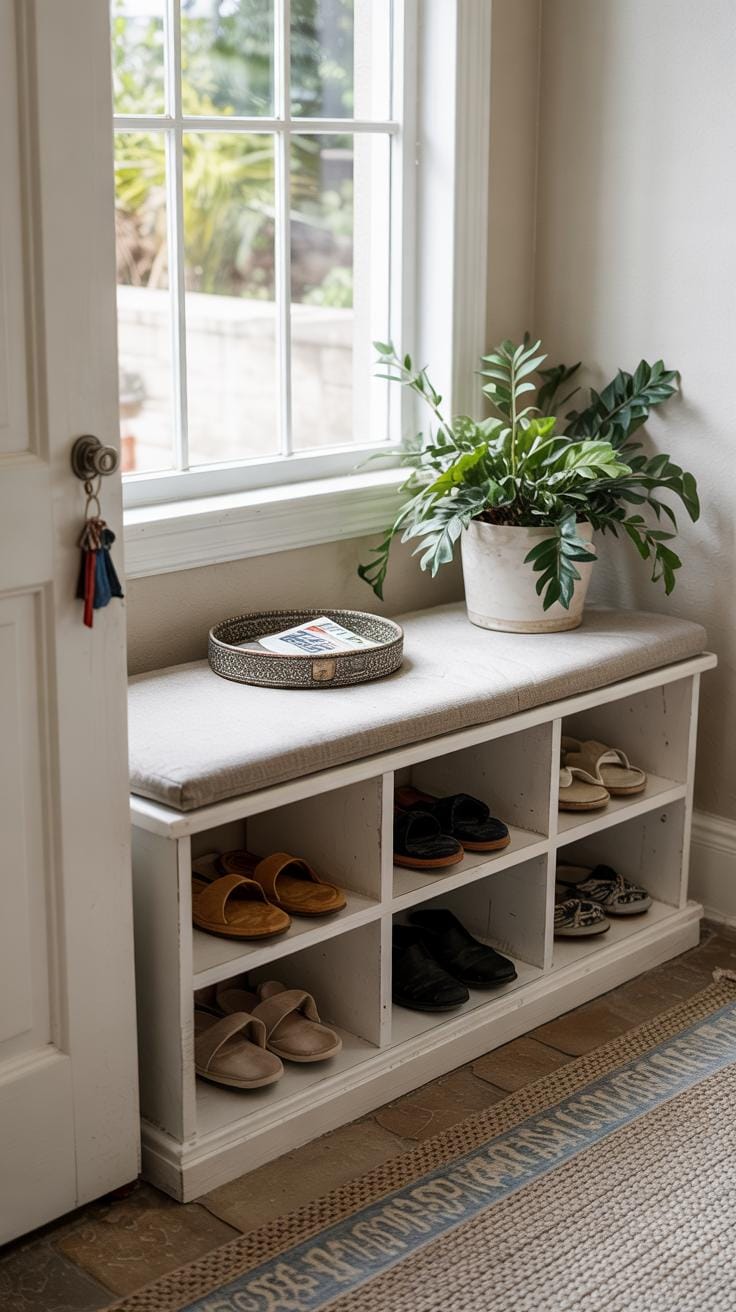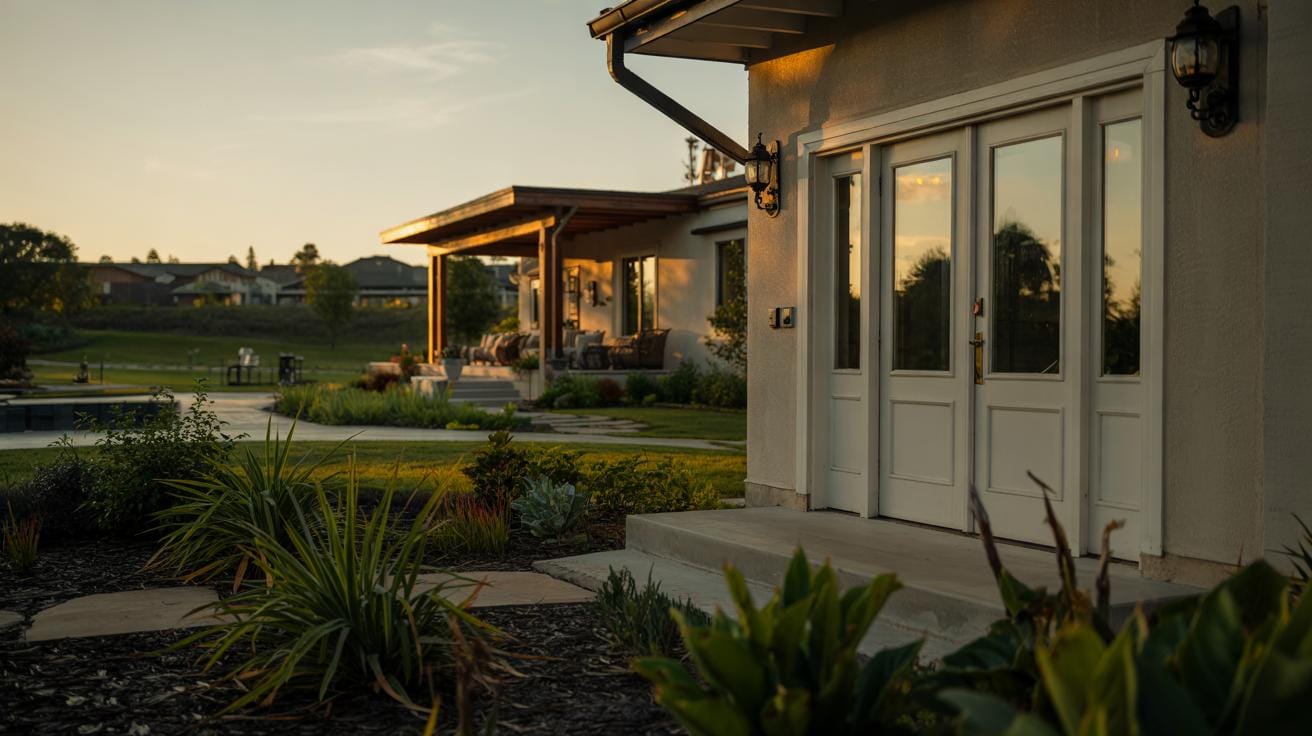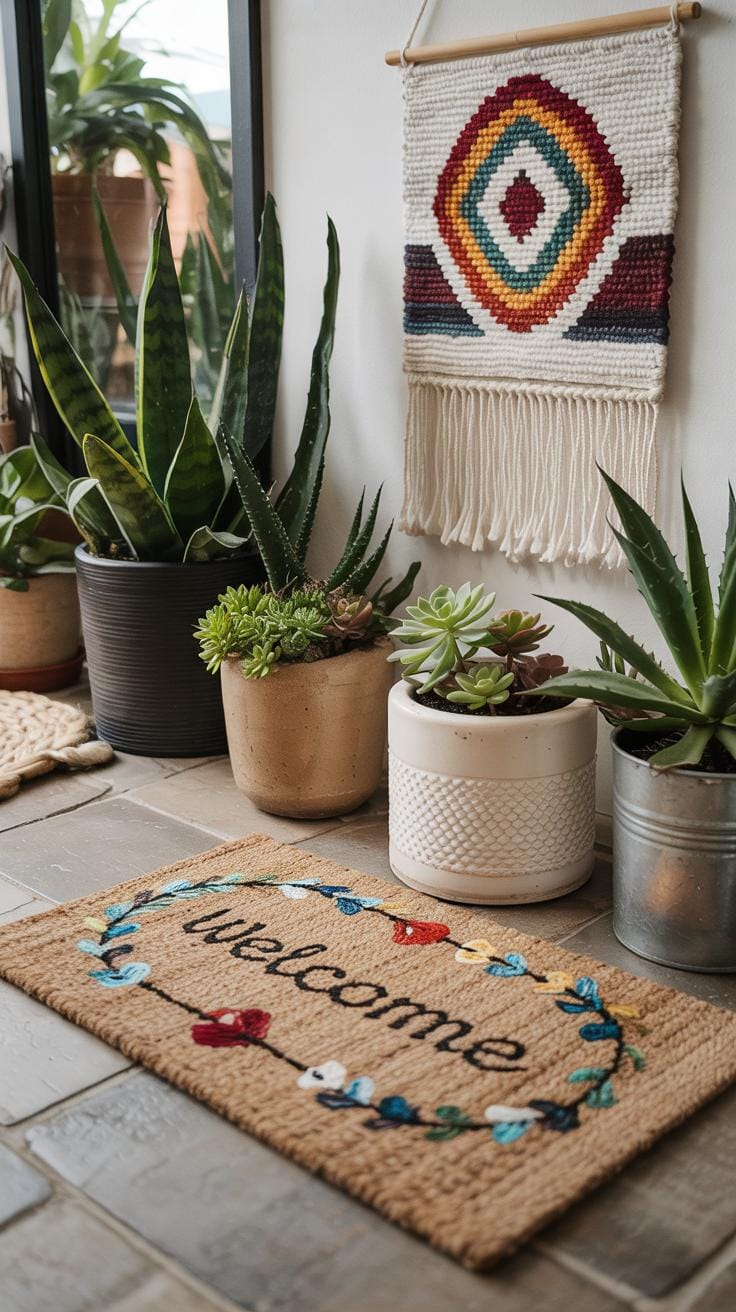Introduction
Your home entrance is the first impression guests get of your living space. It sets the tone for what’s inside and reflects your style. You can use your entryway to welcome visitors warmly and make them feel comfortable right from the start. Is your front door inviting enough? Does your entryway say something about your personality?
Improving your home entrance decor is more than just aesthetics. It combines function and style. You want it to be beautiful but also practical. How about storage options for shoes and coats? What about lighting that highlights your décor and ensures safety? This article will guide you through various home entrance décor ideas and concepts. They will help you welcome guests with flair and create a pleasant first impression.
Understanding the Importance of Your Home Entrance
Your home entrance serves as the first point of contact between your guests and your living space. This initial moment shapes their expectations of what the rest of your home will feel like. A welcoming entrance conveys warmth and care, while a cluttered or cold entry might create unease or disinterest.
Think about when you enter a home. How does the space make you feel? Is it inviting or cold? This emotional response happens quickly and influences how guests interact with the rest of your space. Your entry sets a tone that carries through every room.
Investing attention and design in your entrance is not just about looks. It reflects how you value comfort and hospitality. When you treat your entryway as a key area, it invites guests to relax and feel at ease. What message do you want your entrance to send before a guest even steps inside?
First Impressions Matter
When guests arrive, your entryway shapes their first impression of your home and you. A neat, organized entrance shows care and respect, while a messy space can cause frustration or discomfort. Your entry is often small but powerful—it says a lot without words.
Regularly clearing clutter, maintaining clean surfaces, and adding simple touches like a rug or plant can make a difference. You don’t have to spend much to create a welcoming vibe. Can a worn-out mat or misplaced shoes make guests feel truly invited?
Think about how you want your guests to feel the moment they step inside. Do you want them to relax, smile, or feel excitement? Keeping your entry tidy and welcoming makes it easier for people to settle in and enjoy their time with you.
Balancing Style and Function
Your entrance must look good and support daily life. It’s a space where people pause, remove shoes, hang coats, and transition between outside and inside. This means your entry needs practical features like storage, seating, or hooks, without feeling cramped or messy.
Choosing furniture or décor that fits your style and offers storage solves this challenge. For example, a bench with hidden compartments or a narrow console table with drawers can keep items out of sight but within reach. How can your entry handle the flow of arrivals and departures smoothly?
While style invites guests, function keeps the space livable. Combining both means guests feel welcomed without you losing order. Your entrance should prepare visitors for the comfort and atmosphere awaiting them inside while serving your household needs efficiently.
Choosing the Right Door and Hardware
The front door sets the tone for your home’s entrance and influences how guests feel before they step inside. Selecting the right door style helps underline the theme of your house, whether it’s classic, modern, or rustic. You want a door that fits your home’s architecture and complements the surrounding landscaping and exterior colors.
Consider the door’s material and durability along with aesthetics. Wood doors bring warmth and tradition, while steel doors offer security and sleekness. Fiberglass doors can mimic wood but need less upkeep. Think about how each door style fits your lifestyle and location.
Hardware details like knobs, handles, and locks play a key role in your door’s appearance. They can add a unique touch or reinforce the style you want to display. Choosing hardware that coordinates well with the door and your home’s overall look creates a harmonious design and welcomes guests with flair.
Door Styles That Impress
Panel doors remain popular for their classic look. They add depth and texture with raised or recessed panels and work well with traditional and craftsman-style homes. You can find them in wood or fiberglass for varied looks.
Doors with glass inserts bring light and openness to your entrance. Frosted or decorative glass offers privacy while still welcoming daylight. Stained glass or geometric patterns add personality and draw attention.
Modern minimalist doors often feature clean lines and simple shapes. These designs focus on materials, such as smooth metal, wood slats, or large glass panes. Minimalist doors suit contemporary homes and create a sleek, uncluttered front entry.
Hardware Choices for Personality
Door hardware does more than function; it communicates style. Choose knobs or handles that match the theme of your door and home. For example, wrought iron handles offer a rustic touch, while polished chrome fits well with modern spaces.
Consider the finish of your hardware too. Matte black, brushed nickel, or antique brass can each create different moods. A carefully chosen deadbolt or lock also adds both security and style, blending seamlessly with the other hardware.
Ask yourself what impression you want to give—will your hardware feel inviting and warm, or sleek and refined? Matching hardware across your entryway, like house numbers and doorbells, builds consistency and completes the look.
Utilizing Color and Lighting Effectively
Your home entrance sets the tone for what visitors can expect inside. The colors you choose shape mood and welcome. Warm hues make guests feel at ease the moment they arrive. Think about soft yellows, light oranges, or muted reds for your walls. These colors create a natural friendliness and invite comfort.
Decor accents like cushions, rugs, or plant pots can add small pops of lively color without overwhelming the space. A burnt orange vase or a mustard yellow runner helps carry warmth through your entrance. Do you want to make the space feel larger? Pair warm colors with neutral shades like cream or taupe to balance energy with calm.
Lighting plays a vital role for style and safety at your entrance. Natural light, streaming through sidelights or transom windows around your door, brightens the area during the day and draws visitors in. At night, use layered lighting for both function and effect.
Install wall sconces or pendant lights that cast soft, inviting glows. Choose bulbs with warm color temperatures around 2700K for a cozy feel. Motion-sensor lights not only improve safety but also welcome guests with instant illumination.
Consider how light reflects off your chosen paint colors. Lighter walls brighten with less wattage, while darker tones might need stronger or multiple lights. What mood do you want your entrance to set? The right color and lighting let you craft a space that is both stylish and inviting, helping guests feel welcome before they even step inside.
Incorporating Furniture for Comfort and Utility
Furniture at your home entrance serves both function and style. Seating options offer a comfortable spot for guests to sit while putting on or removing shoes. Surface space provides a place to set keys or bags down as guests arrive. Storage options help keep the area neat by organizing everyday items that tend to clutter entrances.
Choosing the right pieces depends on your space and lifestyle. For example, a small bench with built-in storage gives you a dual-purpose solution. A narrow console table can hold decorative items and essentials like mail trays or bowl for loose change. These kinds of furniture create utility without sacrificing style, making your entrance practical and welcoming.
Ask yourself what your guests need when entering your home. Do they often stay a moment to remove coats or shoes? Will you need quick access to stored items? Answering these questions guides your choices and makes your entrance work better for everyone.
Seating Ideas for Convenience
Benches, chairs, and stools add charm and usefulness to your entrance. A bench offers enough room for more than one person. Look for options with cushions or soft upholstery to make sitting enjoyable.
Individual chairs or stools work well when space is limited. They are easy to move and can add a splash of color or texture. Consider stools that tuck under tables to save space.
Think about the height and comfort of each seating choice. Guests will appreciate a spot that makes it easier to dress or pause for a moment. Which seating style fits your entrance size and your guests’ needs?
Storage Options to Reduce Clutter
Shoe racks keep footwear organized and off the floor. A simple wooden or metal rack fits many spaces and helps maintain tidiness. Coat hooks or wall-mounted racks provide spots to hang jackets and bags without crowding the floor.
Baskets or bins offer flexible storage. Use them beneath benches or on shelves to hold scarves, gloves, or umbrellas. You can choose open baskets for easy access or closed bins for a cleaner look.
Evaluate how many shoes, coats, and accessories your household and guests typically bring inside. Having storage ready reduces clutter and creates a calm, welcoming space instead of a chaotic one.
Adding Decorative Elements That Reflect Your Style
Your home entrance sets the tone for visitors as soon as they step in. To make it stylish and personal, think about adding decorative items that show your character. Rugs bring warmth and texture, while artwork adds color and a story to your walls. Mirrors can make the space feel bigger and brighter by reflecting light.
Plants bring life and a fresh touch that welcomes people naturally. Choose pots and plant types that fit your taste, whether it’s a tall leafy plant or small succulents on a shelf. Look for artwork that connects with you, whether it’s family photos, prints from your favorite artist, or handmade crafts. These elements should not compete but work together to create a balanced and inviting entrance.
Have you thought about what your entrance says about you? Picking pieces that make you feel at home will help guests feel welcomed too.
Choosing Rugs and Mats for Function and Beauty
Select a rug or mat that fits your entryway’s size and traffic level. Durable materials like wool, jute, or indoor-outdoor blends protect the floor from dirt and wear. Rugs add texture, helping your entrance avoid feeling flat or dull.
Consider rugs with patterns or colors you love. Patterns hide dirt well and maintain a clean appearance longer. If your entrance receives heavy foot traffic, a low-pile or flat-weave rug will be easy to clean and last longer. Place rugs so they cover main walkways without causing tripping hazards.
Ask yourself, does this rug match my home’s style and needs? Prioritizing both function and beauty will keep your entryway looking great and practical for everyday use.
Plants and Artwork to Personalize Space
Living plants add color and vitality that artificial décor often lacks. A single large plant can fill an empty corner, while small plants on a console table bring subtle greenery. Choose plants that thrive indoors with low light if your entrance lacks natural sunlight.
Artwork allows you to express your personality visually. Display pieces that inspire you or have meaning. Framed prints, family photos, or a locally made craft create a unique focal point. Mixing natural elements with art keeps the entry lively and engaging.
Think about what kind of mood you want your entrance to create. Do you prefer calm and simple or vibrant and energetic? Matching plants and art to your personal style helps refresh your space and welcome guests warmly.
Maintaining Cleanliness and Organization
Keeping your home entrance clean and organized helps set the right tone for visitors. A messy entryway can create stress and leave a poor impression. Focus on creating a space that feels open and easy to navigate, even during busy days.
Think about the items that pile up as you come home—shoes, mail, bags. Giving each object a specific spot helps control clutter. Regularly clear out what is not needed, like old flyers or broken umbrellas. Daily attention prevents messes from building up.
Ask yourself what you use most at the entrance. Can you simplify the layout to keep essential things within reach? Use surfaces and storage in ways that encourage tidiness. A clean entrance is not just about appearance but also about comfort and calm for everyone who steps inside.
Daily Habits to Keep Tidy
Small daily actions keep your entryway neat. Before leaving the house and when returning, take a moment to put items back in place. Hanging coats immediately or placing shoes on a rack saves time later.
Wipe down surfaces each day to remove dust and dirt. Spend a minute organizing mail into a designated basket. These habits stop clutter before it starts. Pick one or two routines that fit your lifestyle to make tidiness automatic.
How often do you check and clear this area? Making it part of your daily schedule helps maintain a welcoming space effortlessly.
Organizational Tools That Help
Using the right tools transforms your entrance into a neat zone. Trays catch keys and loose items so they don’t scatter. Baskets hold scarves, hats, or gloves in one tidy pile rather than sprawled across surfaces.
Labels on hooks and bins guide everyone to put things back correctly. Shoe racks keep footwear off the floor and organized by type or size. Consider a small bench with storage to combine seating and space for bags or shoes.
Which tools suit your space and needs? Adding simple containers or racks creates order and reduces time spent searching for everyday items.
Design for Small and Narrow Entryways
Small or narrow entryways can feel cramped and challenging to decorate. However, thoughtful choices help make the space practical and welcoming. Consider how to balance functionality with style without overcrowding the area.
Start by evaluating what you truly need in the entryway. Do you require storage for shoes or a spot to sit and put on boots? Removing unnecessary items frees up space. Opt for slim furniture that fits the scale of the area. Choose pieces that serve more than one purpose to get the most out of every inch.
Using vertical space works well in tight areas. Tall shelves or hooks can keep items off the floor and reduce clutter. Think about lighting, too. Bright, warm lights help prevent narrow spaces from feeling dark or closed in. With some adjustments, even the smallest entryway can greet guests with style and ease.
Space-Saving Furnishings
Compact furniture makes a big difference in a small entryway. Narrow benches with built-in storage let you sit and stash away shoes or bags. Floating shelves mounted on the wall take up no floor space but hold keys and mail.
Multipurpose pieces work best. A fold-down desk can double as a workspace or landing spot for daily essentials. A slim console table with drawers keeps clutter hidden but items within reach. Chairs that tuck under tables leave pathways open.
Try to find furniture designed specifically for small spaces. These often have slimmer profiles, fewer bulky details, and smart storage solutions built in. Could you use a storage ottoman to add both seating and hidden compartments? Choosing the right furnishings saves space and keeps your entryway tidy.
Visual Tricks to Open the Space
Visual design can make a narrow entryway feel much larger. Mirrors are a simple tool that reflect light and give the illusion of depth. Hang a tall mirror opposite the door or near the light source. This bounces natural or artificial light around the room.
Choose light colors on walls and floors to keep the space bright. Neutral shades or soft pastels prevent the entry from feeling enclosed. Glossy surfaces, like polished floors or lacquered furniture, also reflect extra light.
Focus light toward corners and darker spots. Slim wall sconces or recessed lighting work well without taking up floor space. Would adding a mirror or changing paint colors encourage you to rethink your entryway’s design? These simple tricks help the space appear open and inviting.
Seasonal Updates to Refresh Your Entrance
Changing your home entrance decor with the seasons brings freshness and keeps your space welcoming all year. Simple swaps can make your entry feel new without much effort or cost. Starting with colors, you might choose warm oranges and reds in autumn or bright pastels in spring to match the time of year. Seasonal plants like mums in fall or tulips in spring can add life and texture.
Think about small decorative touches like wreaths or lanterns that reflect the season’s mood. For example, pinecone wreaths in winter or floral ones in spring introduce natural elements tied to the season. You can swap out doormats and pillows to reflect these changes too, making the entrance appear thoughtfully styled. How often do you update your porch to match the seasons? Even small changes keep your guests intrigued and your home feeling lively.
Seasonal Colors and Accessories
Choose colors that highlight each season’s character. Cool blues and whites fit winter, while sunny yellows and greens work well for summer. Autumn calls for deep reds, burnt oranges, and golds. Spring suits soft pinks, lilacs, and fresh greens.
Incorporate wreaths made of seasonal materials like berries, leaves, or pine. Lanterns with candles or solar lights provide warmth during darker months. Grouped planters with seasonal flowers or grasses add dimension. Changing the doormat to reflect the season’s palette or theme also creates an inviting detail without crowding your entrance.
Seasonal Maintenance Tips
Different seasons demand different care for your entrance area. In fall, clear away fallen leaves daily to avoid slippery spots and keep the area neat. Winter requires snow and ice removal while protecting wooden or stone surfaces from salt damage by sweeping regularly.
Springtime is perfect for washing windows, sweeping away winter dirt, and inspecting fixtures. Summer calls for watering potted plants and trimming overgrowth to keep the pathway clear. Regular maintenance prevents clutter and damage, ensuring your styled entrance remains attractive and safe for your guests.
Enhancing Security With Stylish Elements
Security does not have to come at the cost of style when designing your home entrance. You can choose security devices that blend seamlessly with your décor while keeping your home safe. Look for smart locks with sleek designs that fit modern or classic door styles. These locks offer keyless entry and allow you to control access remotely through your smartphone.
Cameras and doorbell systems have become smaller and less intrusive. You can install a compact CCTV camera that matches your exterior color to avoid standing out. Some models even come with decorative covers or can be hidden within light fixtures or planters.
Ask yourself if your current security setup feels harsh or off-putting to guests. Integrating technology in a subtle, aesthetically pleasing way can make your entrance both secure and welcoming.
Smart Locks and Surveillance
Smart locks provide easy access control without bulky hardware. Choose models with clean lines and neutral tones that complement your door’s color or material. Some locks have touchscreen pads or fingerprint sensors designed to be discreet and modern.
CCTV cameras no longer need to look industrial. Devices with compact frames and adjustable mounts let you position them where they stay out of direct sight but cover key areas. Video doorbells combine security with convenience, sending alerts and video feeds to your phone.
These tools allow you to monitor who approaches and enter your home while preserving the style of your entrance.
Designing for Secure but Welcoming Entry
Think about the layout of your entrance to create safety without sacrificing charm. Position your pathway to avoid blind spots and use low walls or fences that don’t block sightlines but still define the space.
Lighting plays a major role. Install warm, well-placed lights that brighten your door and walkways while avoiding glare. Motion-activated lights provide security and add a dynamic touch by welcoming guests with soft illumination as they arrive.
Create a clear, open entry point. Does your entrance invite visitors to stop and wait comfortably? A small bench or covered porch with good lighting can make guests feel safe and welcomed. Secure design is about blending protection with hospitality.
Conclusions
Designing an impressive home entrance requires a blend of creativity and practical planning. From selecting the right door and hardware to incorporating inviting colors and lighting, every element contributes to the overall appeal. Have you considered how each piece in your entryway works together? The way you arrange furniture or add plants can change the atmosphere significantly.
A home entrance that welcomes guests with flair strengthens your home’s character. It shows attention to detail and care for your visitors. Reflect on the ideas shared here. Which concepts resonate most with your style and needs? Apply them thoughtfully, and you will see how a well-designed entryway enhances your home’s charm and functionality.

